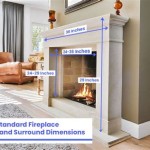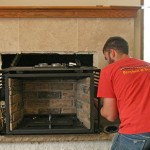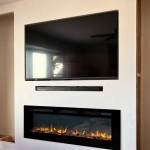```html
Real Stone Fireplace Ideas: A Comprehensive Guide
Real stone fireplaces offer a timeless aesthetic, bringing warmth, character, and a natural element to any living space. Their durability and unique visual appeal make them a popular choice for homeowners seeking to enhance both the ambiance and value of their property. This article explores various real stone options, design considerations, and installation factors to help inform the decision-making process when planning a real stone fireplace project.
The term "real stone" encompasses a wide variety of materials quarried directly from the earth. These differ significantly in terms of color, texture, density, and porosity, all of which affect their suitability for fireplace construction. Choosing the right type of stone is crucial for achieving the desired aesthetic and ensuring the longevity of the fireplace.
Selecting the Right Stone: Key Considerations
The selection of stone for a fireplace should be based on a number of factors. The desired style, budget constraints, structural considerations, and the overall design of the room all play a role. Each type of stone brings unique characteristics to the table, influencing the final look and feel of the fireplace.
Stone Type and Aesthetics: Some of the most common stone types used in fireplaces include fieldstone, river rock, stacked stone, and quarried stone such as limestone, granite, and slate. Fieldstone, typically found on farms and rural landscapes, offers a rustic and natural appearance. River rock, smooth and rounded by water erosion, provides a softer, more organic feel. Stacked stone, often composed of thin, rectangular pieces, delivers a contemporary and streamlined aesthetic. Quarried stones, like limestone and granite, provide a more formal and refined look, offering a wide range of colors and textures.
Budget: The cost of real stone varies significantly depending on the type of stone, its availability, and the complexity of the installation. Quarried stones, especially those imported from distant locations, tend to be more expensive than locally sourced fieldstone or river rock. Installation costs also vary depending on the complexity of the design and the skill of the mason or contractor. It is important to obtain multiple quotes and factor in all material and labor costs before making a final decision.
Structural Considerations: Real stone is heavy, so the fireplace structure must be designed to support the weight of the stone veneer. In some cases, additional structural support may be required, especially for large stone fireplaces. A qualified structural engineer should be consulted to assess the load-bearing capacity of the existing floor and walls and to recommend any necessary reinforcement.
Room Design and Style: The fireplace should complement the overall design and style of the room. A rustic stone fireplace may not be the best choice for a modern minimalist living space, while a sleek, stacked stone fireplace might feel out of place in a traditional farmhouse. Consider the color palette, furniture, and other architectural elements when selecting the stone for the fireplace to ensure a cohesive and harmonious design.
Design Styles and Layout Ideas
The design possibilities for real stone fireplaces are virtually limitless. From traditional hearths to contemporary statement pieces, the design can be tailored to suit any taste and architectural style. Several design styles are particularly well-suited for incorporating real stone.
Traditional Fireplaces: Traditional stone fireplaces often feature a large hearth, a substantial mantel, and intricate stone detailing. These fireplaces are typically constructed with fieldstone, river rock, or limestone, radiating warmth and timeless elegance. The hearth often serves as a focal point, providing a place to sit and enjoy the warmth of the fire.
Rustic Fireplaces: Rustic stone fireplaces emphasize natural textures and earthy tones. They are typically constructed with fieldstone, river rock, or rough-cut limestone, creating a cozy and comfortable atmosphere. These fireplaces often incorporate reclaimed wood mantels and natural stone accents, enhancing their rustic charm.
Contemporary Fireplaces: Contemporary stone fireplaces feature clean lines, minimalist designs, and sleek stone surfaces. They are often constructed with stacked stone, slate, or granite, creating a modern and sophisticated look. These fireplaces may incorporate glass doors, stainless steel accents, and integrated lighting to enhance their contemporary appeal.
Outdoor Fireplaces: Outdoor stone fireplaces extend the living space to the outdoors, providing a gathering place for family and friends. They are typically constructed with durable stones such as granite, limestone, or fieldstone, able to withstand the elements. Outdoor fireplaces can be designed as freestanding structures or integrated into patios, decks, or outdoor kitchens.
Fireplace Layout and Room Integration: The fireplace layout should be carefully considered to maximize its visual impact and functionality. The fireplace can be positioned as a central focal point in the room or placed along a wall to create a cozy corner. The size and scale of the fireplace should be proportionate to the size of the room. Consider the placement of furniture and other architectural elements to ensure a harmonious and balanced design.
Installation Process and Considerations
Installing a real stone fireplace is a complex process that requires careful planning, skilled craftsmanship, and adherence to building codes. It is generally recommended to hire a qualified mason or contractor experienced in stone fireplace construction to ensure a safe and successful installation.
Structural Preparation: Before installing the stone, the fireplace structure must be properly prepared. This may involve reinforcing the existing floor and walls, constructing a sturdy foundation, and installing a fire-resistant backing board. The structure must be able to support the weight of the stone veneer and withstand the heat generated by the fireplace.
Stone Cutting and Shaping: Depending on the type of stone and the desired design, the stones may need to be cut and shaped to fit the fireplace structure. This requires specialized tools and techniques to ensure precise cuts and a seamless finish. The stones should be carefully arranged to create a visually appealing and structurally sound veneer.
Mortar Application: Mortar is used to adhere the stones to the fireplace structure and to fill the gaps between the stones. The mortar should be carefully mixed and applied to ensure a strong and durable bond. The type of mortar used should be appropriate for the type of stone and the climate conditions.
Sealing and Finishing: Once the mortar has cured, the stone fireplace should be sealed to protect it from moisture and stains. A stone sealant can help to prevent water absorption and to make the stone easier to clean. The fireplace can also be finished with a decorative sealant or stain to enhance its appearance.
Building Codes and Safety: It is essential to comply with all applicable building codes and safety regulations when installing a real stone fireplace. These codes typically cover fire safety, structural integrity, and ventilation requirements. A qualified building inspector can provide guidance and ensure that the fireplace meets all applicable standards.
Beyond these core areas, various ancillary aspects contribute to the overall success of a real stone fireplace project. Considerations like flue sizing, damper operation, and proper ventilation play critical roles in ensuring the fireplace operates safely and efficiently.
Flue Sizing: The size of the flue should be appropriately matched to the size of the fireplace opening. An undersized flue can lead to smoke backdrafts into the room, while an oversized flue can result in inefficient draft and heat loss. A qualified chimney sweep or fireplace installer can properly calculate the required flue size based on the fireplace dimensions and local building codes.
Damper Operation: A properly functioning damper is essential for controlling airflow within the fireplace and preventing heat loss when the fireplace is not in use. The damper should be inspected regularly and repaired or replaced if necessary. A top-sealing damper can provide a more airtight seal than a traditional throat damper, reducing heat loss and improving energy efficiency.
Ventilation: Adequate ventilation is crucial for ensuring complete combustion and preventing the buildup of carbon monoxide. The fireplace should be connected to a properly functioning chimney or flue that vents the exhaust gases safely to the outside. A carbon monoxide detector should be installed in the room to provide an early warning of any dangerous gas leaks.
Ultimately, a real stone fireplace represents a significant investment that can enhance the beauty and value of a home. By carefully considering the various factors outlined above, homeowners can make informed decisions and create a stunning focal point that provides warmth, comfort, and lasting enjoyment.
```
Stone Veneer Fireplaces Natural Facing

Best Stone Fireplace Ideas

Natural Stacked Stone Veneer Fireplace Ideas

50 Sensational Stone Fireplaces To Warm Your Senses

Best Stone Fireplace Ideas

Faux Stone Fireplace No Mortar Mess Box To The Wall Genstone

Stone Veneer Interior Design Living Room Kitchen Bedroom Ideas More Buechel
:max_bytes(150000):strip_icc()/Interior-Impressions-Prior-Lake-Minnesota-Lakeside-Living-Living-Room-Stone-Fireplace-White-Mantel-5490deb0d1c04f63a8cd78ca8d70f3bc.jpeg?strip=all)
36 Best Stone Fireplace Ideas For A Cozy Home

4 Natural Stacked Stone Fireplaces For Your Dream Design

Stone Fireplace Design And Remodel
Related Posts








